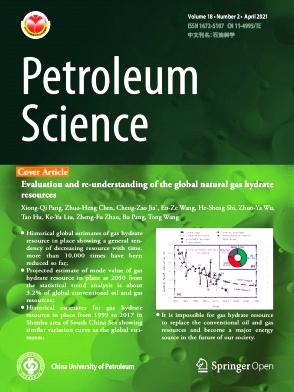新西兰Taranaki盆地深水区Romney三维地震区晚白垩世—第四纪层序地层学及沉积演化
IF 6.1
1区 工程技术
Q2 ENERGY & FUELS
引用次数: 0
摘要
层序地层学的研究往往集中在浅海和陆架边缘地区,而对深海层序的研究相对薄弱。本研究以高分辨率三维地震数据和钻井信息为基础,以层序地层学和地震沉积学为指导,采用地震解释方法对新西兰Taranaki盆地深水Romney三维地震调查区内的深海地层层序进行了划分。在此基础上,分析了典型沉积体系特征及其控制因素。结果表明:(1)根据地震反射终止关系和地震相特征,确定了4个二级层序边界和9个三级层序边界,圈定了3个二级层序和12个三级层序。(2)识别出5种地震相,对应5种典型沉积体:大块搬运沉积、深水河道沉积、堤防沉积、三角洲沉积和远洋沉积。但由于碳酸盐岩沉积厚度较薄,地震资料无法识别碳酸盐岩沉积的地震相特征,只能通过井资料进行识别。三角洲沉积主要发育于盆地裂谷期,碳酸盐岩沉积形成于被动边缘向活动边缘过渡期。在活动边缘阶段出现了深水水道和堤防沉积和MTDs,而海洋环境中则普遍存在远洋沉积。(3)新西兰内陆的隆升和气候侵蚀导致碎屑沉积物重新抬头,碎屑沉积物开始向深海输送,海底地形会直接影响沉积物重力流的运动路径,沉积物供给会影响沉积体系的发育演化。(4)河道形成的侵蚀冲刷面和MTDs形成的不整合面等事件沉积边界可作为深水层序划分的边界。本研究提出了一种利用事件沉积圈定深水层序的方法,特别适用于相对海平面变化对深水沉积影响相对较弱的情况。该研究不仅增强了对深水沉积层序的认识,而且为世界上具有类似地质背景的研究地区研究深水沉积演化及其控制因素提供了参考。本文章由计算机程序翻译,如有差异,请以英文原文为准。
Sequence stratigraphy and sedimentary evolution from Late Cretaceous to Quaternary in the Romney 3D seismic area, deep-water Taranaki Basin (New Zealand)
The study of sequence stratigraphy often focuses on shallow marine and shelf-edge regions, while research on deep-sea stratigraphic sequences remains relatively weak. This study, based on high-resolution 3D seismic data and drilling information, utilized sequence stratigraphy and seismic sedimentology as guidelines, and employed seismic interpretation methods to performed a division of deep-sea stratigraphic sequences within the Romney 3D seismic survey area in the deep-water Taranaki Basin, New Zealand. Furthermore, it analyzed the characteristics of typical depositional systems and their associated controlling factors. The findings are as follows: (1) Based on seismic reflection termination relationships and seismic facies characteristics, four second-order sequence boundaries and nine third-order sequence boundaries were identified, resulting in the delineation of three second-order sequences and twelve third-order sequences in the basin. (2) Five seismic facies were recognized, corresponding to five typical sedimentary bodies: mass transport deposits (MTDs), deep-water channel, levee deposits, deltaic deposits, and pelagic deposits. However, due to the relatively thin sedimentary thickness of carbonate sediments, the seismic facies characteristics of carbonate sediments cannot be discerned in seismic data, but can be identified based on well data. Deltaic sediments mainly developed during the rift stage of the basin, while carbonate sediments formed during the transition from a passive to an active margin. Deep-water channel and levee deposits and MTDs emerged during the active margin stage, while pelagic deposits are ubiquitous in marine environments. (3) The uplift of New Zealand's interior and climate-driven erosion caused the resurgence of clastic sediments, which began to be transported to the deep sea, the seafloor topography would directly affect the movement path of sediment gravity flow, and sediment supply can affect the development and evolution of sedimentary systems. (4) Event deposits boundaries, such as erosional scour surfaces formed by channels and unconformities created by MTDs, can serve as boundaries for the division of deep-water stratigraphic sequences. This study proposes a method for delineating deep-water stratigraphic sequences using event deposits, particularly suitable under conditions where the influence of relative sea-level changes on deep-water deposits is relatively weak. This research not only enhances the understanding of deep-water depositional sequences but also provides a reference for studies on the evolution of deep-water deposition and its controlling factors in research areas with similar geological backgrounds worldwide.
求助全文
通过发布文献求助,成功后即可免费获取论文全文。
去求助
来源期刊

Petroleum Science
地学-地球化学与地球物理
CiteScore
7.70
自引率
16.10%
发文量
311
审稿时长
63 days
期刊介绍:
Petroleum Science is the only English journal in China on petroleum science and technology that is intended for professionals engaged in petroleum science research and technical applications all over the world, as well as the managerial personnel of oil companies. It covers petroleum geology, petroleum geophysics, petroleum engineering, petrochemistry & chemical engineering, petroleum mechanics, and economic management. It aims to introduce the latest results in oil industry research in China, promote cooperation in petroleum science research between China and the rest of the world, and build a bridge for scientific communication between China and the world.
 求助内容:
求助内容: 应助结果提醒方式:
应助结果提醒方式:


